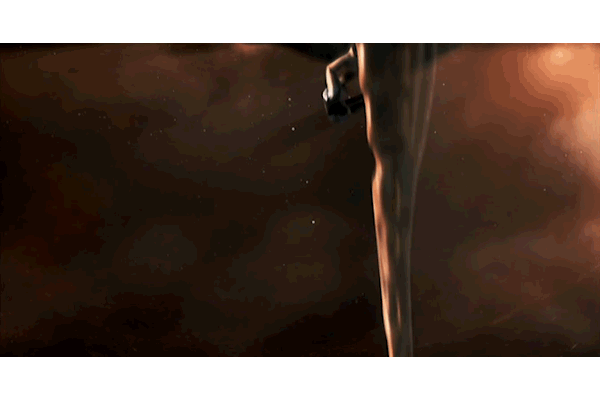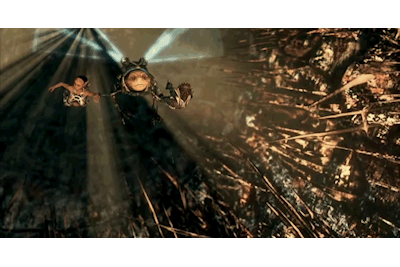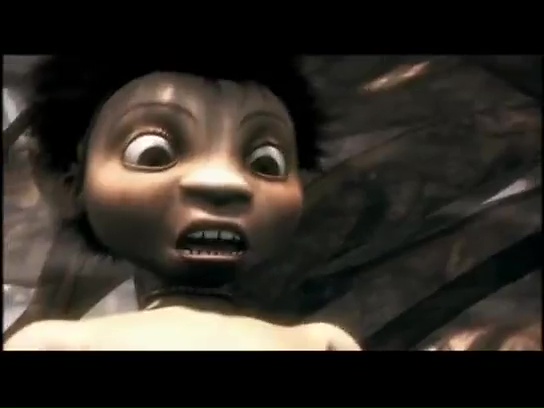A plodding anti-religion parable set on an alien planet, Kaena: The Prophecy’s flaws seem to justify its “nobody’s heard of it” status. Despite some inspired ideas (and an intriguing erotic-techno-biophilic setting), it’s watchable mainly as a study of wasted potential. If a ever fire burned in this film, it went out long ago.
It’s a French CGI film from 2003, created by Chris Delaporte and Patrick Daher, and produced by Xilam on a budget of $26 million. It grossed just $2,173 on its opening weekend. You’d have made more money in March 2020 with an educational film titled How To Lick Every Surface At Your Local Pub.
Kaena was released on DVD, where it theoretically could have recouped its losses. Considering the DVD’s 87 Amazon reviews, far fewer than heavy-hitters like Morbius (3,488 reviews) or Mars Needs Moms (1,151 reviews), I’m reasonably certain that Kaena: The Prophecy did not Kaena: A Profit See.
I will attempt to describe Kaena’s story. My ability to do so is hindered by the reality that it’s confusing and I don’t care.

A spaceship crash-lands on an alien planet. Its crew is massacred by the natives (vicious blobs of sap called Selenites), but the ship’s sentient core survives, sprouting into a gigantic tree called Axis that extends a hundred miles into space. We then jump ahead six hundred years. A primitive humanlike race of creatures now lives beneath the branches of Axis, high above clouds that (from their upside down perspective) they regard as the sky. They slave tirelessly to harvest sap for the ground-based Selenites, who have tricked them into thinking they’re gods. Until one day, a girl named Kaena grows curious about what’s really beneath the sky.

The setup’s there, but the delivery isn’t. Kaena’s lore-heavy setting (with several races, superintelligent AIs, and two species of genetically engineered worms) is more complicated than you want in a movie where the villain is a blob of sap. The story also has an incomplete, threadbare quality, as though you’re playing a videogame with half the cutscenes erased from the disk, and it’s often hard to understand what’s happening, or how event B connects to event A.
My guess is that important scenes were written and storyboarded, and then cut due to financial constraints. I don’t know if that’s true, yet it often felt that Kaena’s writers expected me to know facts without having troubled themselves to explain them to me.
The villain’s entire motive is that she wants to avoid “fusion”, which apparently is how the Selenites reproduce. (The vizier gently tells the queen that she must think of her species’ future. The queen scornfully retorts “You are the last male! You crave fusion with me!” She’s got us males figured out, I guess.) I don’t understand what fusion entails, or why she doesn’t want to do it, so her behavior is incomprehensible. If the Selenites depend on sap from Axis’s trunk to survive, why are they trying to destroy the ship’s computer, which is obviously the source of the tree? And the tree didn’t exist until the ship arrived, so where were they getting sap from before?
The film has a lot of “coupon shots”: my term for a money shots that is ruined by the fact that you don’t understand or care about the big reveal. In the third act, the character Opaz reveals a secret about Axis’s true nature. It’s played up as a big moment. Kaena reacts in awe. I reacted with “so what?” I couldn’t see how it affected anything.
The film seems to piously insist that it has a brilliant concept, and that this should excuse its every shortcoming. A tree in space! A race that lives upside down! They stare up at heaven…and it’s the Earth! Isn’t that profund? Heaven is on Earth!
But movies do not exist in their outlines. I cannot watch concepts. Kaena’s plot isn’t compelling in the slightest. It’s “Noble savages with a magic tree are enslaved by a technologically superior race who are posing as gods, then a rebellious teenage girl with mystic visions goes on a hero’s journey to save them”. In other words, dead husk-like fragments of FernGully, Pocahontas, Princess Mononoke, The Prince of Egypt, Starchaser: The Legend of Orin, and A Bug’s Life, coated in obscurantist Franco-glaze. You may as well watch James Cameron’s Avatar, which adapts about 75% of this movie’s plot without even realizing it, and at least makes the tree-worshipping cat people sparkly blue instead of poop-brown.
On that note…how does the the film look?
Kaena herself is superbly bouncy and appealing. She’s constantly in motion: leaping and falling and tumbling and getting ragdolled around by physics. She’s ruthlessly designed to strike one chord in teenage girls, and a different, louder one in teenage boys.

Other parts of the movie look awful. As in, “Welcome to 1994, we are now watching Re:Boot outtakes and the animators are on drugs” awful. I do not support abortion, but if I saw someone slinging this child’s coathanger-riddled corpse into a Planned Parenthood dumpster, I would not tell a soul. Some things are for the greater good.

The rest of Kaena’s tribe look nondescript, in a featureless “NPC in a cheap videogame” way. The eye stares straight past them.

2000-2004 was “the best of times, and the worst of times” for CGI. The technology could look incredible, but it was still novel (and expensive) enough that objectively horrible shit was regularly defecated into theaters.
Kaena embodies this cinematic weltanschauung: here you get incredible and horrible, in one movie! There’s a huge unevenness in how the film looks, as if it was made not just by different people but by different studios.
The making-of documentary behind Kaena is informative. The film was worked on piecemeal by various people, many of whom had no business making a movie at all. I was not surprised to learn that Kaena was originally meant to be a videogame. It began almost a decade earlier at Eric Chahi’s Amazing Studios (Out of this World has a faint but recognizable influence on Kaena‘s style). 1995 was an era of multimedia-heavy games that blurred the line between cinema and videogaming, and after Toy Story‘s success (and some encouraging feedback from Lucas and Spielberg), Delaporte and Daher left Amazing and began work on a “cinematic” game called Gaina.
Gaina was soon re-imagined as TV movie called Axis, and then rebuilt again as an animated feature. Delaporte and Daher were game developers, and they made a movie that doesn’t feel like one. They animated it with commercial 3D software of the sort used by videogame developers, such as Discrete’s Character Studio. Certain details—like the hands of characters—aren’t as detailed as they would be in a Pixar film. After all, you don’t have detailed hands in a game.
The project bumped along for years, held back by outdated tools, an inexperienced team, and the eventual bankruptcy of Delaporte’s studio. Kaena was bought by Xilam Animation (of Oggy and the Cockroaches fame), and hauled over the finish line, after rehiring most of the original team.
I’ll say this: some of the animators and character designers knew what they were doing. Kaena herself is great, and so are the Selenites, who have a creative HR Giger-inspired design. Their environment is cleverly conceived: a vile, chiaroscuro’d hellhole that seems made of congealed maple syrup.

Kaena definitely could have used more money, but writing is cheap, and that’s the part where it falls apart.
The villains are puzzling in their motives. Opaz is has been doing nothing for six hundred years. The worms are Timon and Pumba style comic relief characters that can fuck off. Kaena, the cynosure at the film’s center, lacks any sort of characterization at all. She’s just a plucky young teenager who is saintly and good and always ready to stand up to authority.
The human village is ruled by a grating one-note character, clearly meant as a stand-in for organized religion. His every line of dialog is some version of “The gods are testing us!” and “The gods are demanding another harvest of sap!” He turns into a droning irritating presence, without any depth or nuance. At times the movie becomes an atheist screed, three years before that was popular. But the film’s “think for yourself” bona-fides are questionable, since Kaena’s basically a mystic herself, motivated by dreams.
2003 was probably a bit late to make a movie like Kaena. It wants to be a vaguely edgy movie aimed at teens. Treasure Planet and Titan AE had already tried that, and flopped. I think the world just saw another unmarketable foreign movie, and passed.
Many such cases. In 2003, CGI was still regarded as a groundbreaking new art form instead of a movie-ruining plague, and we had a whole trend of lavish CGI “films” that were actually more like hundred-million-dollar Maya showcases (think Final Fantasy: The Spirits Within and The Polar Express). The Hollywood press would reliably hype them with breathless technobabble about 360 degree mocap and realistic light specularity and characters with 60,000 individually animated strands of hair, along with speculation that human actors would soon be obsolete.
It was a bubble. Most of these films failed, losing their studio tens of millions of dollars and sometimes bankrupting them in the process. In reality, only Pixar and Dreamworks could reliably score a chunky 3-5x return on a CGI film, and nearly everyone else was left holding a bag (usually one with poorly-animated cloth physics). Even Disney got burned a bunch of times before figuring out a formula. With a few exceptions (Ice Age made a bunch of money, somehow), there wasn’t a CGI boom, there was a Pixarworks boom.
(We see a similar trend today with superhero franchises. People regard them as this omnipresent thing that can’t fail, but actually, the only studio making it work is Marvel. DC’s Extended Universe failed, and Universal’s Dark Universe sputtered out after one movie. The plates are kept spinning by Kevin Feige’s diabolical touch. When he dies or leaves the company, who knows what will happen?)
Kaena got caught right as the industry bubble burst. (A new one, of course, started with 3D, and Avatar). But even if had come out in 2001, it has severe problems. It’s dark and confused and slow. It’s loaded with rampant fanservice that would probably repulse parents and female viewers. The action scenes come and go. The animation is literally the horse drawing meme for ninety minutes, swapping competence for incompetence at random moments. The fluid physics and realistic hair are paired with characters that look like they’re from a shitty TV show or web series. There’s exposition instead of action. The movie’s modal scene is “dollar-store Ent philosophizes about the nature of being to a girl wearing clothes so fetishistically tight you could diagnose a uterine cancer in her pelvis”. If you want that sort of thing, check out Aeon Flux.
Kaena is a rough movie to love. It’s more of an archeological dig than a film: I’m disinterested in what the movie is, but fascinated by what it was originally trying to do. Almost all bad movies have a murdered good movie hiding in the frame, and that’s definitely true in this one’s case.
No Comments »
Comments are moderated and may take up to 24 hours to appear.
No comments yet.

